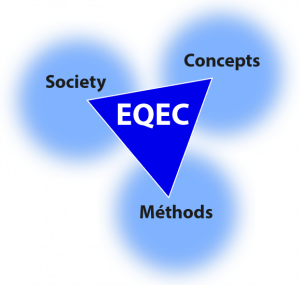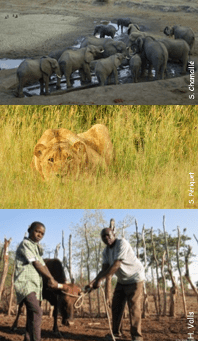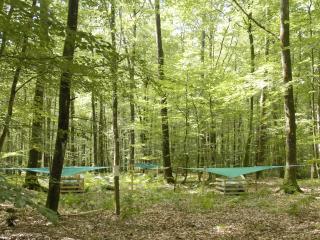Quantitative and Evolutionary Ecology of Communities Group
Members

Doctorante
UCBL

Professeure des universités
VetAgro-Sup
Tel: 33 04 72 43 27 56

Directeur de recherche
CNRS
Tel: 33 04 72 43 27 57

Doctorant
UCBL
Tel: 04 72 44 81 42

Doctorant
CNRS
Tel: 04 72 44 81 42
Doctorant
VetAgro-Sup

Maître de conférences
UCBL
Tel: 04 72 44 81 42
Doctorant
UCBL


Professeur des universités
UCBL
Tel: 33 04 72 43 27 56

Professeur des universités
UCBL

Directeur de recherche
CNRS
Tel: 33 04 72 43 27 56

Maîtresse de conférences
UCBL
Tel: 33 04 72 43 29 02
Maître de conférences
UCBL
Tel: 33 04 72 43 29 02

Our research activities, focused on interspecific interactions (community ecology), aim to better understand the ecological and evolutionary processes structuring species assemblages and biodiversity at different temporal and spatial scales. Our team addresses these major issues using contrasting biological models (communities of large African mammals, insects, microbiota, plants) from 3 complementary angles:
- Our work is strongly anchored in the conceptual framework of evolutionary biology by studying (i) the diversity of adaptive responses implemented by organisms to selective pressures in their environment, (ii) their consequences on population demography and ultimately (iii) the dynamics and composition of species communities.
- Our research is closely linked to societal issues of biodiversity conservation and management by integrating both the functioning of socio-ecological systems and the context of climate change. We conduct experimental studies, manage and ensure the long-term monitoring of several community observation networks.
- Methodological issues also occupy a central place in our team, with the development of new tools for statistical processing and modeling of ecological data. This activity leads to the development of methods and software that we develop and distribute freely.
Research programs

Functioning of African savanna communities
The Hwange LTSER (Long-Term Socio-Ecological Research site in Zimbabwe hosts a long-term interdisciplinary research program that focuses on the functioning of plant and animal communities within the Hwange National Park and the interactions between this protected area and humans living in its periphery. Based on this program, three axes are developed: (1) studying the population dynamics of elephants, exploring their impact and that of management policies on the socio-ecosystem functioning; (2) Understanding the extent to which interactions within and between trophic levels are sensitive to management actions (e.g. sport hunting, water management) and climate change; (3) Decoding human ecology and human-wildlife coexistence mechanisms towards integrated conservation and sustainable functioning of the socio-ecosystem. This research is complemented by more recent works in the Hluhluwe-iMfolozi Park and in the Madikwe reserve in South Africa, which focus on the role of environmental conditions on the hunting success of large African carnivores. We work in close collaboration with the IRL (International Research Lab) Rehabs.
Involved group members : Alice Bernard, Laura Lacomme, Aïssa Morin, Lisa Nicvert, Elie Pedarros, Yolan Richard, Marion Valeix*

Masting and the community dynamics of seed consumers
Masting is a reproductive strategy often encountered in perennial plants, characterized by fructifications highly fluctuating in time and being synchronized at the population level. The seeds produced that way constitute a pulsed resource with a strong impact on the eco-evolutionary dynamics of seed-consuming communities and forest regeneration. Our lack of knowledge of this system still impedes our understanding of the dynamics of temperate forest ecosystems and its future in the context of climate change. Our work carried out on oak forests aims to better understand (i) the proximal causes of masting, (ii) the mechanisms underlying the coexistence of species competing for such highly fluctuating resource and (iii) the co-evolution of consumer exploitation strategies for the fluctuating resource and forest tree fruiting strategies. On the basis of the results obtained, scenarii will be proposed on the future of forest regeneration under climate change, that may serve forest management.
Involved group members : Marie-Claude Bel-Venner*, Emilie Fleurot, Léa Keurinck, Jean Lobry, Samuel Venner

The spread of antibiotic resistance genes in bacteria
Antibiotic resistance is recognized as one of the greatest current threats to human health, and the mobile genetic elements (MGEs) that circulate in bacterial populations and communities are the main vehicles. To understand the dynamics and diversity of MGEs in bacterial pangenomes and the emergence of antibiotic resistance genes, we propose to go beyond the framework of conventional genomics by considering pangenomes as complex ecological communities. In the Ab-One program, we mobilize the concepts and tools developed in community ecology based on an integrative approach (monitoring of bacterial populations/communities evolving in contrasting environments -One-Health approaches-, pan-genomic analyses, experimentation in molecular and cellular microbiology, mathematical modelling). This program is currently focused on the dynamics of MGEs in Acinetobacter baumannii, an antibiotic-resistant microorganism classified as a priority by the WHO. Other more general approaches will illustrate the relevance of this new conceptual framework to understand the dynamics and diversity of MGEs in bacterial pangenomes. This program, co-piloted by our team and a team from CIRI (Horigene) involves the participation of 9 organizations (6 from Lyon -LBBE, CIRI, MMSB, HCL, LEM, VetAgro Sup-, Institut Pasteur (Paris), LMGM (Toulouse ), Robert Koch Institute (Germany)).
Involved group members : Stéphane Dray, Rémi Tuffet, Samuel Venner*

Statistical analysis of ecological data
Understanding the structure and dynamics of species assemblages, and the processes behind them, requires collecting data that are becoming increasingly complex owing to the sophisticated technological developments made available for their acquisition (e.g. GPS, loggers, satellite imagery, molecular data). We are developing new methods for analysing such data, that provide new insights into the ecological processes at work in communities. Multivariate analysis methods allow the analysis of spatial structures, accounting for various information on species (functional traits, morphology, phylogeny), the spatio-temporal variation of species-environment relationships or the multifaceted perception of the protected human-environment relationship. We also model multi-'omics' dose-response data within communities in order to better understand the Adverse Outcome Pathway (AOP) and to better appreciate the risks to the environment. These methodological innovations are made available to the scientific community through the development, distribution and maintenance of software (libraries for the R language: ade4, adegraphics, adephylo, ade4TkGUI, nlstools, fitdistrplus, DRomics, seqinr).
Involved group members: Marie Laure Delignette-Muller, Stéphane Dray*, Jean Lobry, Jean Thioulouse.
Publications
Display of 301 to 330 publications on 656 in total
fitdistrplus : An R Package for Fitting Distributions
Journal of Statistical Software . 64 ( 4 )
Journal article
see the publicationConsidering external information to improve the phylogenetic comparison of microbial communities: a new approach based on constrained Double Principal Coordinates Analysis (cDPCoA)
Molecular Ecology Resources . 15 ( 2 ) : 242-9
Journal article
see the publicationGenerating spatially constrained null models for irregularly spaced data using Moran spectral randomization methods
Methods in Ecology and Evolution . 6 : 1169-1178
Journal article
see the publicationRevisiting the link between breeding effort and oxidative balance through field evaluation of two sympatric sibling insect species
Evolution - International Journal of Organic Evolution . 69 ( 3 ) : 815–822
DOI: 10.1111/evo.12586
Journal article
see the publicationConstructing Time-Resolved Species Sensitivity Distributions Using a Hierarchical Toxico-Dynamic Model
Environmental Science and Technology . 49 ( 20 ) : 12465-12473
Journal article
see the publicationA Toolbox for Nonlinear Regression in R: The Package nistools
Journal of Statistical Software . 66 : 1-21
Journal article
see the publicationPrincipal component analysis with missing values: a comparative survey of methods
Plant Ecology . 216 ( 5 ) : 657-667
Journal article
see the publicationPotentialities of ecological engineering strategy based on native arbuscular mycorrhizal community for improving afforestation programs with carob trees in degraded environments
Ecological Engineering . 79 : 113-119
Journal article
see the publicationSoil Organic Matter Quality, Structure and Activity of the Denitrifiers Community as Influenced by Decaying Mulched Crop Residues
Applied Ecology and Environmental Research . 13 : 655-675
Journal article
see the publicationMOSAIC_SSD: A new web tool for species sensitivity distribution to include censored data by maximum likelihood
Ecotoxicology and Environmental Safety . 33 ( 9 ) : 2133 - 2139
DOI: 10.1002/etc.2644
Journal article
see the publicationHierarchical modelling of species sensitivity distribution: development and application to the case of diatoms exposed to several herbicides
Ecotoxicology and Environmental Safety . 114 : 212-221
Journal article
see the publicationCorrelated percolation models of structured habitat in ecology
Physica A: Statistical Mechanics and its Applications . 416 : 290-308
Journal article
see the publicationHow do habitat filtering and niche conservatism affect community composition at different taxonomic resolutions?
Ecology . 95 ( 8 ) : 2179-2191
DOI: 10.1890/13-0064.1
Journal article
see the publicationHow root traits are modified in secondary succession gradient along roadsides ?
BES and SFE Joint Annual Meeting . : np
Conference paper
see the publicationDesigning ‘trait-based null model’ approaches to investigate community assembly mechanisms
BES and SFE Joint Annual Meeting 2014 . : np
Conference paper
see the publicationModification des traits racinaires le long d’une succession secondaire sur des talus routiers: implications dans la dynamique des communautés et la protection des sols contre l’érosion
Ecoveg 10 . : np
Poster
see the publicationProcesos ecológicos a múltiples escalas que afectan a las dinámicas de comunidades de plantas en los humedales altoandinos de Bolivia - Multi-scale ecological processes driving plant community dynamics in high-elevation peatlands of Bolivia
Ecologia en Bolivia . 49 ( 3 ) : 104-120
Journal article
see the publicationCharacterizing the phylogenetic tree community structure of a protected tropical rain forest area in Cameroon
PLoS ONE . 9 : e98920
Journal article
see the publicationDetermining the instar of a weevil larva (Coleoptera: Curculionidae) using a parsimonious method
European Journal of Entomology . 111 ( 4 ) : 567-573
Journal article
see the publicationCombining the fourth-corner and the RLQ methods for assessing trait responses to environmental variation.
Ecology . 95 ( 1 ) : 14-21
DOI: 10.1890/13-0196.1
Journal article
see the publicationSimilar Processes but Different Environmental Filters for Soil Bacterial and Fungal Community Composition Turnover on a Broad Spatial Scale
PLoS ONE . 9 ( 11 ) : 1-11
Journal article
see the publicationStatistical handling of reproduction data for exposure-response modeling
Environmental Science and Technology . 48 : 7544-51
DOI: 10.1021/es502009r
Journal article
see the publicationSpatially constrained clustering of ecological networks
Methods in Ecology and Evolution . 5 ( 8 ) : 771-779
Journal article
see the publicationAnalysing a pair of tables : coinertia analysis and duality diagrams
Visualization and Verbalization of Data . 978-1-4665-8980-3 : 289-300
Book chapter
see the publicationStatistical ecology comes of age
Biology Letters . 10 ( 20140698 ) : np
Journal article
see the publicationFunctional analysis of normalized difference vegetation index curves reveals overwinter mule deer survival is driven by both spring and autumn phenology
Philosophical Transactions of the Royal Society B: Biological Sciences . 369 ( 1643 ) : 20130196
Journal article
see the publicationEctomycorrhizal fungi on the early colonizing shrub Sarcolaena oblongifolia F. facilitate the establishment of an endemic tree Uapaca bojeri L. in Madagascarian highland forests
International Journal of Ecology and Ecosolution . 1 : 1-15
Journal article
see the publicationDevelopment and validation of an OECD reproductive toxicity test guideline with the pond snail Lymnaea stagnalis (Mollusca, Gastropoda)
Regulatory Toxicology and Pharmacology . 70 ( 3 ) : 605-614
Journal article
see the publicationDo spatially-implicit estimates of neutral migration comply with seed dispersal data in tropical forests?
PLoS ONE . 8 ( 8 ) : np
Journal article
see the publicationManaging Mediterranean nurse plants-mediated effects on soil microbial functions to improve rock phosphate solubilization processes and early growth of Cupressus atlantica G
Ecological Engineering . 57 : 57--64
Journal article
see the publication
You also, comment on this article